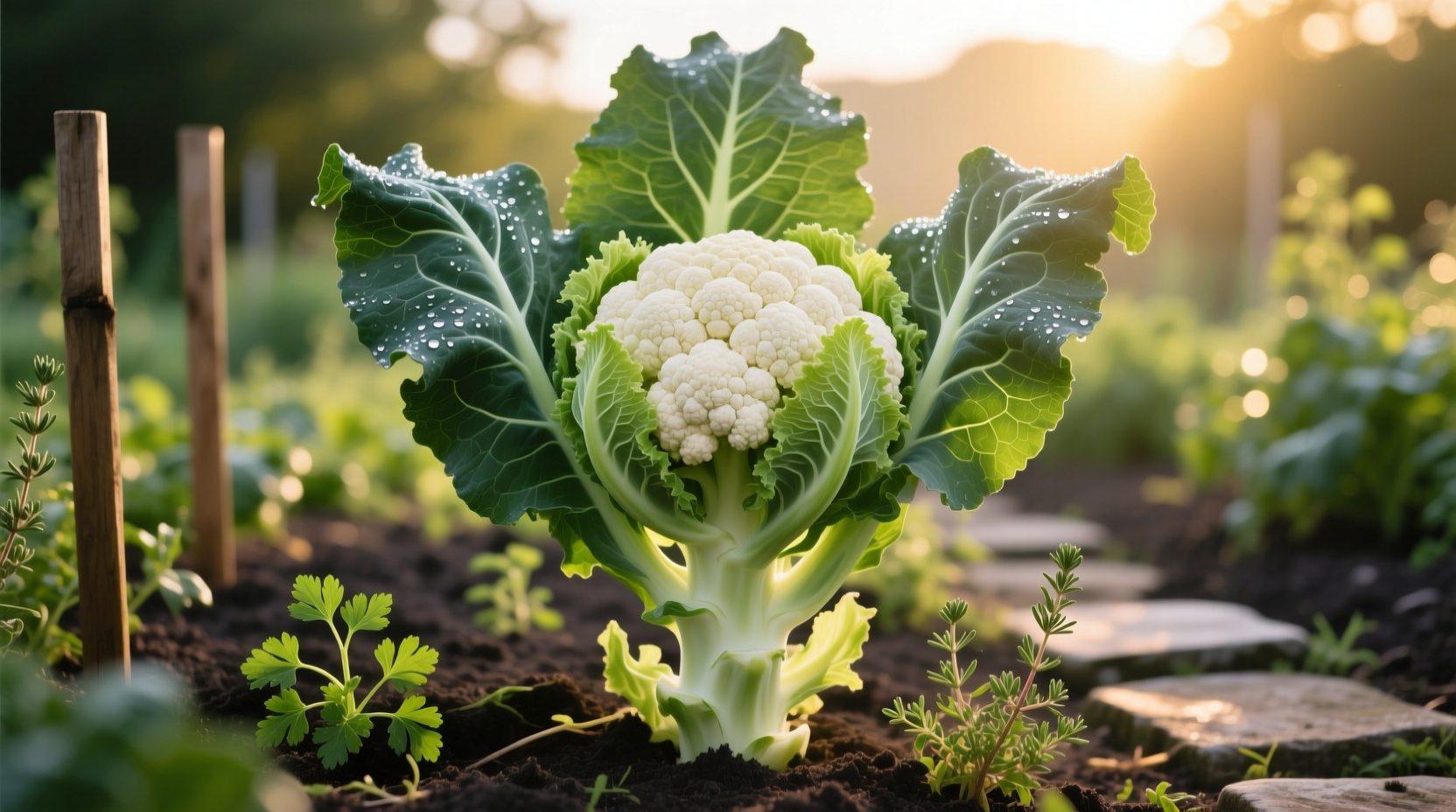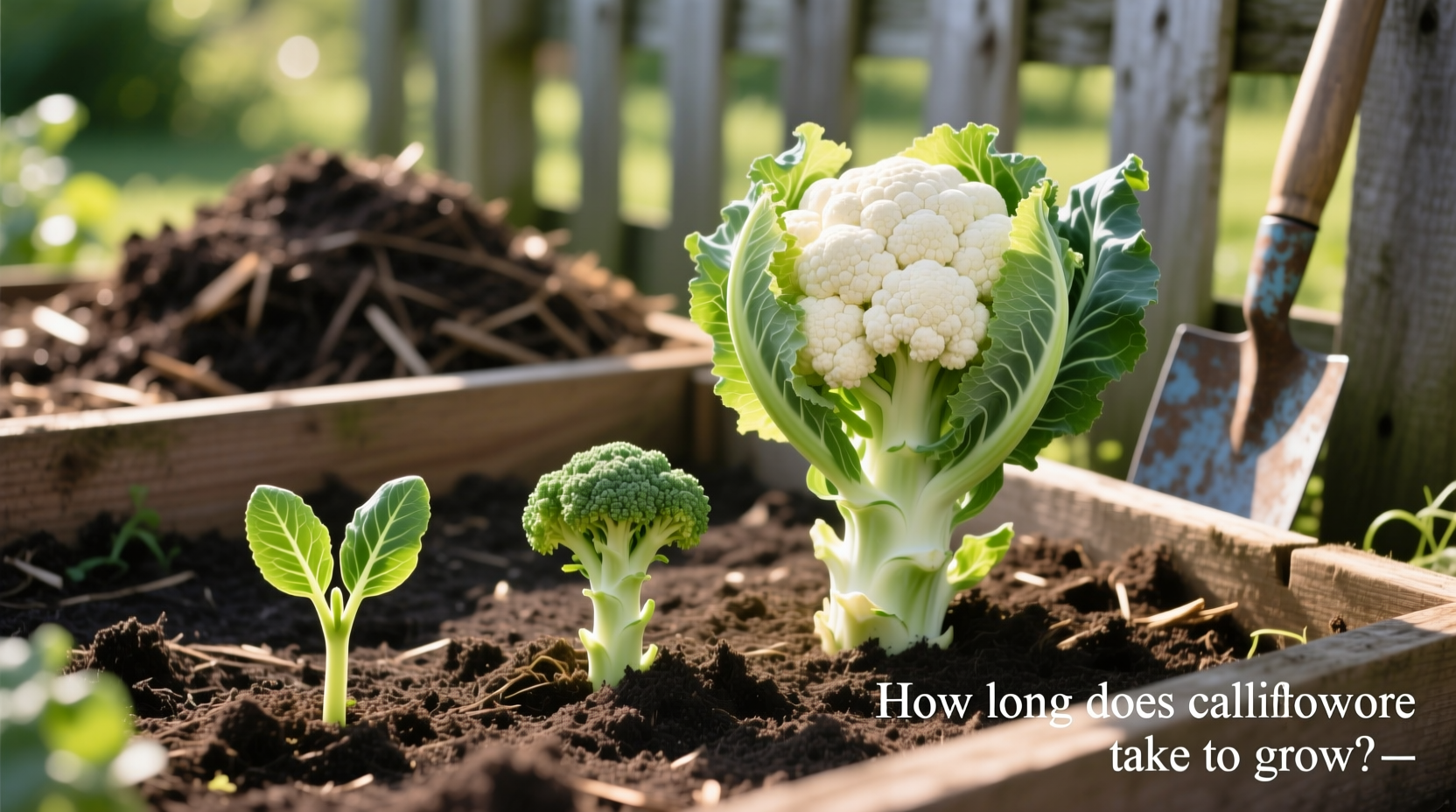Understanding exactly how long does cauliflower take to grow is essential for garden planning and harvest success. Whether you're a beginner gardener or expanding your vegetable patch, knowing the precise timeline helps you coordinate planting with your local climate and avoid common pitfalls that lead to disappointing yields.
Decoding Cauliflower Growth Stages
Cauliflower development follows distinct phases, each with specific time requirements. Unlike many vegetables, cauliflower has narrow temperature tolerances that significantly impact its growth rate. The journey from seed to harvestable head involves several critical transitions:
- Germination stage: 4-10 days at optimal soil temperatures (70-80°F/21-27°C)
- Seedling development: 4-6 weeks before transplanting outdoors
- Vegetative growth: 3-5 weeks of leaf development before head formation
- Head initiation: 2-4 weeks of compact curd development
- Maturation: Final 7-14 days for head sizing and firming
Missing these narrow windows—particularly during head formation—can result in premature bolting, buttoning (tiny heads), or ricey curds. The cauliflower growth stages timeline varies considerably based on environmental factors and cultivar selection.
Factors That Determine Your Actual Harvest Timeline
While general timelines provide a framework, your specific growing conditions dramatically affect how many days does cauliflower take to grow. Understanding these variables helps adjust expectations and improve success rates:
| Factor | Impact on Growth Time | Optimal Conditions |
|---|---|---|
| Variety selection | Early varieties: 50-70 days Mid-season: 70-85 days Late-season: 85-100+ days |
Choose varieties matching your growing season length |
| Temperature | Below 50°F (10°C): Stunted growth Above 80°F (27°C): Poor head formation |
60-68°F (15-20°C) ideal for head development |
| Soil quality | Nutrient-deficient soil: Adds 10-20 days to maturity | pH 6.0-7.0, rich in organic matter, consistent moisture |
| Planting method | Direct seeding: Adds 20-30 days vs. transplants | Start seeds indoors 4-6 weeks before last frost |
This cauliflower varieties growth comparison shows why selecting appropriate cultivars for your climate zone is crucial. Early varieties like 'Snow Crown' mature in 55-60 days but offer less cold tolerance, while late-season types such as 'Gardner' require 90+ days but produce larger heads with better storage potential.
Step-by-Step Growing Timeline for Perfect Heads
Follow this actionable sequence to maximize your cauliflower growing season length and harvest success:
Weeks 1-2: Seed Starting (Indoors)
Plant seeds ¼ inch deep in seed trays at 70-75°F (21-24°C). Maintain consistent moisture—dry conditions cause poor germination. At day 5-7, thin to one plant per cell. University of California Agriculture and Natural Resources confirms that proper early moisture management prevents seedling stress that delays maturity by 10-14 days.
Weeks 3-6: Seedling Development
Provide 14-16 hours of light daily. Begin hardening off seedlings at week 5 by gradually exposing them to outdoor conditions. This critical phase determines whether your plants will establish quickly after transplanting or experience setback delays. Cornell University Cooperative Extension emphasizes that proper hardening reduces transplant shock that typically adds 7-10 days to maturity timelines.
Weeks 7-10: Transplanting and Establishment
Transplant when seedlings have 4-5 true leaves, spacing plants 18-24 inches apart. Apply balanced fertilizer at planting. The first 10-14 days after transplanting represent a vulnerable period where temperature fluctuations can trigger premature head formation (buttoning). During this phase, consistent soil moisture is critical—fluctuations cause hollow stem development that delays harvest.
Weeks 11-14: Vegetative Growth
Plants develop 15-20 healthy leaves before initiating head formation. Side-dress with nitrogen-rich fertilizer when plants reach 12 inches tall. This leaf development phase directly impacts final head size—insufficient foliage results in small, underdeveloped curds. Monitor for pests like aphids that stunt growth and extend maturity time.
Weeks 15-18: Head Formation
As temperatures stabilize between 60-68°F (15-20°C), compact curds begin forming. For white varieties, tie leaves over developing heads (blanching) when curds reach 2-3 inches across. This protects against sun discoloration and maintains quality. Temperature spikes above 75°F (24°C) during this phase cause ricey, coarse-textured heads that never properly mature.
Weeks 19-22: Maturation and Harvest
Harvest when heads reach 6-8 inches in diameter and feel firm. Delaying harvest beyond peak firmness causes separation of curd segments (riciness). Most gardeners achieve best results harvesting in early morning when temperatures are coolest. The when to harvest cauliflower heads window typically lasts just 3-5 days before quality declines.
Avoiding Common Timeline Disruptions
Several issues can extend your cauliflower growth stages timeline beyond expected maturity dates:
- Temperature stress: Exposure to temperatures below 50°F (10°C) triggers premature head formation (buttoning), while heat above 80°F (27°C) causes poor curd development
- Nutrient deficiencies: Boron deficiency creates hollow stems that delay maturity by 10-15 days
- Water inconsistency: Fluctuating moisture levels cause buttoning or curd discoloration
- Pest damage: Aphid infestations stunt growth, adding 7-14 days to maturity
According to USDA Agricultural Research Service field trials, maintaining consistent soil moisture through drip irrigation reduces maturity time variance by 12-18% compared to inconsistent watering methods. Additionally, applying a balanced fertilizer with adequate boron prevents hollow stem development that commonly delays harvest.

Regional Planting Strategies for Optimal Timing
Your geographic location significantly impacts best time to plant cauliflower for harvest. Successful growers adjust planting schedules to match local climate patterns:
- Cool coastal regions: Plant in early spring for summer harvest or late June for fall harvest
- Continental climates: Start seeds indoors February-March for spring planting; July for fall crop
- Warmer southern zones: Plant September-October for winter harvest; avoid summer planting
University of Minnesota Extension research shows that fall-planted cauliflower typically matures 5-7 days faster than spring-planted crops in the same location due to more stable temperature conditions during critical head formation stages. This cauliflower growing season length variation demonstrates why regional adaptation matters.
Harvesting and Post-Harvest Handling
Knowing exactly when to harvest cauliflower heads prevents wasted effort. Harvest when:
- Heads reach 6-8 inches in diameter (varies by variety)
- Curds feel firm and compact
- Individual florets remain tight (not separating)
- Color remains pure white (for standard varieties)
Cut heads with 1-2 inches of stem attached, leaving outer leaves for protection. Immediately cool harvested heads to 32-40°F (0-4°C) to maintain quality. Properly stored cauliflower remains fresh for 2-3 weeks in refrigerator conditions—significantly longer than many gardeners expect.
Troubleshooting Growth Delays
If your cauliflower seems behind schedule, check these common issues:
- Buttoning (tiny heads): Caused by temperature stress or root-bound seedlings—adds 10-14 days to recovery
- Ricey curds: Result from temperature fluctuations during head formation—often unrecoverable
- Discolored heads: Sun exposure (white varieties) or nutrient deficiencies—affects quality but not maturity timeline
- Hollow stems: Boron deficiency or rapid growth—delays harvest by 7-10 days
For buttoning issues, remove the small heads and provide optimal growing conditions—the plant may produce secondary heads in 10-14 days. This recovery technique, documented by Cornell University researchers, salvages crops that would otherwise be lost.
FAQ: Common Cauliflower Growing Questions
How long does it take cauliflower to grow from seed to harvest?
Cauliflower takes 80-120 days from seed to harvest under optimal conditions. Early varieties mature in 80-90 days, mid-season types in 90-100 days, and late-season varieties require 100-120 days. Starting with transplants reduces this timeframe by 20-30 days compared to direct seeding.
What's the fastest growing cauliflower variety?
'Snow Crown' is among the fastest maturing varieties, ready for harvest in 55-60 days from transplanting. This early-season hybrid performs best in spring plantings and produces 6-8 inch white heads. For fall harvests, 'Amazing' matures in 60 days with excellent heat tolerance.
Why is my cauliflower taking longer than expected to mature?
Extended maturity periods typically result from temperature stress (below 50°F or above 80°F), inconsistent watering, nutrient deficiencies (particularly boron), or pest damage. Transplant shock can add 7-10 days to maturity. Ensure consistent soil moisture, proper fertilization, and appropriate variety selection for your climate to achieve expected harvest timelines.
Can you grow cauliflower in containers and how does it affect growth time?
Yes, cauliflower grows well in containers with a minimum 5-gallon capacity and proper drainage. Container-grown plants typically mature 5-7 days faster than in-ground plants due to better temperature control of the root zone. However, they require more frequent watering and feeding, as soil in containers dries out quicker and nutrients deplete faster.
How do I know when cauliflower is ready to harvest?
Harvest when the head reaches 6-8 inches in diameter (check variety specifications), feels firm to gentle pressure, and maintains tight, compact curds. The individual florets should not be separating or showing rice-like texture. For white varieties, the head should remain pure white without yellowing. Harvest in early morning for best quality and longest storage life.











 浙公网安备
33010002000092号
浙公网安备
33010002000092号 浙B2-20120091-4
浙B2-20120091-4